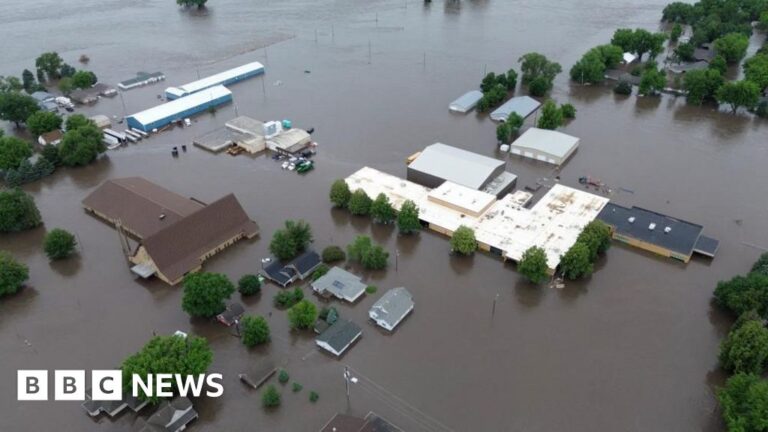- author, Nadine Yousif
- role, BBC News
-
More than a million people were under flood warnings in the upper Midwest on Sunday after days of heavy rain forced evacuations and rescue efforts in several states.
Iowa and South Dakota were hardest hit, with some rivers reaching record highs.
South Dakota Governor Kristi Noem said at least one person has died in flooding in her state.
Iowa Governor Kim Reynolds called the flooding “catastrophic” and declared a state of disaster for 21 counties.
Drone footage posted by local authorities showed homes and buildings almost completely submerged, with only their roofs visible.
In the northeastern Iowa town of Spencer, water gauges were completely submerged.
“When the flood gauge is below water level, the water is really high,” Eric Tiggs of Clay County Emergency Management said at a press conference Sunday.
Hundreds of homes in the town were damaged and the city’s sewage treatment plant was flooded, authorities said.
Other states with flood warnings in effect over the weekend include Nebraska, Minnesota and Wisconsin.
A flood warning means flooding is imminent or ongoing.
According to a National Weather Service bulletin, some warnings are expected to be lifted later on Sunday, while others will remain in effect until further notice.
Iowa officials said the river had risen above the level of the 1993 flood that killed 50 people.
Torrential rainfall of up to 18 inches (45 cm) fell in some areas this weekend.
In South Dakota, Governor Noem declared a state of emergency and warned that the worst flooding was expected on Monday and Tuesday, with water levels on the Big Sioux River potentially rising above record levels.
About 4,000 residents of Rock Valley, Iowa, about 50 miles (80 kilometers) southeast of Sioux Falls, were forced to evacuate on Saturday after water levels in the Rock River rose to record highs.
Rock Valley city officials said residents in the area lacked access to clean tap water because floodwaters contaminated wells.
Flooding left several people and animals stranded in the city early Saturday, prompting helicopter rescue efforts.
In Wisconsin, the severe weather also destroyed a historic church in the village of Argyle, according to the local diocese. The Apple Grove Lutheran Church, founded in 1893, was completely destroyed by the tornado on Saturday evening.
The severe storm comes as parts of the US are in the grip of a week-long heatwave, with some cities breaking daily temperature records.
More than 100 million people were under heat warnings as of Sunday, with many warnings expected to be extended until early next week.
Sweltering summer temperatures are expected to reach nearly 100 degrees Fahrenheit (37 degrees Celsius) in some areas, with heat waves affecting cities and towns from the Mid-Atlantic to the Lower Mississippi Valley and across the Great Basin and California.
In Oklahoma, temperatures are expected to reach 107°F (41°C) on Sunday.
Record-high temperatures are also likely in the Mid-Atlantic region, including Washington, D.C., and New York City, according to the NWS.
Several records were broken on Saturday.
Temperatures in Baltimore reached 101 degrees Fahrenheit (38 degrees Celsius), the hottest day since 1988, according to the NWS.
The heat wave is arriving unusually early for this time of year, and the NWS has warned that in some areas it could be the longest heat wave in decades.
Scientists say extreme weather events are becoming more frequent and intense as a result of human-induced climate change caused by activities such as burning fossil fuels and deforestation.
According to the Intergovernmental Panel on Climate Change (IPCC), the United Nations climate agency, heat waves have become more frequent and intense worldwide since 1950.

